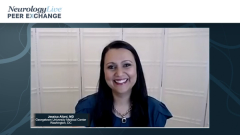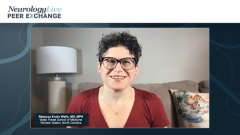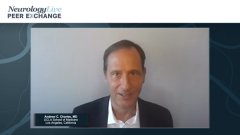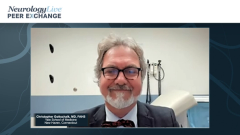
CGRP Monoclonal Antibodies and Patient Treatment Selection
Dr Christopher Gottschalk shares how the clinical trial data for CGRP monoclonal antibodies affect patient selection for preventive migraine treatment.
Episodes in this series

Christopher Gottschalk, MD, FAHS: Just to reinforce some of those ideas and to sort of circle back to the conversation we were having about how our conversations with patients have changed in this new era. The fact is that we’ve grown up in a time where we had to have difficult conversations with patients about trying different prophylactic agents with the idea that this may take 3 to 6 months for you to titrate this, given that you may have tolerability issues. And then once we reach a targeted dose, we’re going to have to wait and see over months whether or not you really have a benefit, and there could be some fairly serious side effects, etc. It could take a year or more to even determine whether there’s a good treatment option under the old model.
When you look at the data from the agents that we’re looking at now, we’re talking about trials where the window of the initial trials might have been 6 months. But, in fact, most patients who respond to these new injectable therapies have a response within a month and most within a week. In the case of eptinezumab [Vyepti], patients who respond typically respond within 24 hours. So that is a life-changing conversation for me to say you don’t have to take something every single day and we’re not going to have to wrestle with this for the next 6 months to a year, but we can try a treatment that we will know whether or not it’s effective almost immediately. And the risk of side effects is dramatically less than the things that we’ve used in the past. All of us have the experience and we have data to support the idea that with the old oral agents that we had, the likelihood that patients were even still taking them 6 months later was like 20% because of all those tolerability issues and the delay in response.
I have rarely had the experience in the new era of somebody who comes back and says, “Yeah, I took a dose or 2 of that shot and I gave up.” They’ll still take it and some occasional patients will say, “I just don’t think it’s doing enough.” But they tend to hang in there. We mentioned earlier that with botulinum toxin, it’s a rare day that you have somebody who says, “No thanks.” All of these opportunities to have a treatment that is effective with minimal risk of side effects and fairly rapid responses allows for establishing, I think, a much stronger relationship with patients that you are providing targeted therapy, you understand much better what the risks and benefits might be and can get to an answer a lot sooner.
Jessica Ailani, MD: I think it is important to point out that many will have a response very quickly. “Even if you respond quickly, it’s important to hang in there because,” I tell them, “This is just the start.” Which they’re always like, “What do you mean? I’m so much better.” I’m like, “Oh, oh but just you wait.”
What is very fascinating to me is we have data that points to long-term response and all of that data ends at around a year. We have data for erenumab [Aimovig] at 5 years, but we’re just starting to see these patients at year 3 to 4 now. I continue to be surprised at my chronic migraine patients who have not been chronic migraine for about 3 years now. I’m starting to feel comfortable dropping the label, they are consistently running 4 days a month and they were 28 or 30 days. And they’re like 4 days crystal clear in between. I mean, you just never thought you were ever going to see that in this lifetime.
Rebecca makes a very good comment. We wish we could figure out how to predict who’s going to be that super responder because that’s the one question we want to know and what the patients want us to answer. Stephanie, I’m going to have you make 1 comment before we turn it over to Chris to talk to us about gepants as preventive options.
Stephanie J. Nahas, MD, MSEd, FAHS, FAAN: I was just reflecting on how this rapidity of response and extremely good tolerability has been so attractive with this class of drug. But, like you pointed out, Chris, some patients are more willing to stick with it for a while and see if it helps. And we have had some patients in our practice that took 9 to 12 months to see an improvement. Now, partly, that was like, well, I’ve got nothing else to do so I’m just going to keep taking it, and this really when these things first just came out. So that also struck me.
Something else that strikes me is that all of these treatments have data for patients who’ve experienced prior treatment failures and they all seem to do better. Their placebo responses are way down in the basement like they don’t expect anything out of it, and they still get some response to it. This is why it’s important not just to look at the actual numbers but to know the population and to look at what the placebo group experienced. Because it kind of challenges our notion of what refractory migraine is. It’s a debatable definition, to begin with, but in a way, we can maybe give some of our patients hope. “I tried 4 medications already, and none of them worked.” Well, it’s just because you didn’t have the right tool in your box perhaps. These medications are actually proven to be beneficial even for those who have experienced prior treatment failure. It’s another way that you can give your patients a little ray of hope and some optimism.
Jessica Ailani, MD: Thank you to our audience for watching this Neurology Live® Peer Exchange. I hope that you’ve enjoyed watching this program as much as we’ve enjoyed spending this time together. If you have enjoyed this content, please subscribe to our e-newsletters to receive upcoming Peer Exchanges and other great content right in your inbox.
Transcript edited for clarity.
Newsletter
Keep your finger on the pulse of neurology—subscribe to NeurologyLive for expert interviews, new data, and breakthrough treatment updates.




































